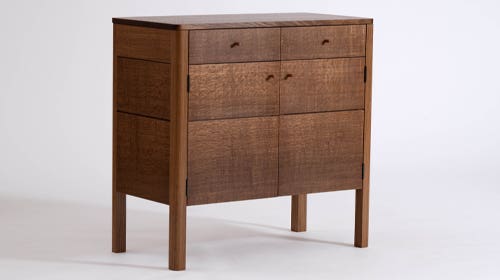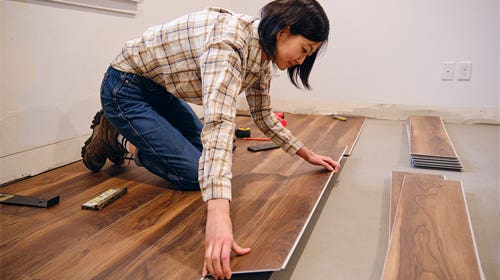Walnut holds steady in weak U.S. market
It’s certainly not the best of times for retail and wholesale walnut dealers, but it’s also not the worst of times. Along with cherry, walnut sales continue to be steady,…
It’s certainly not the best of times for retail and wholesale walnut dealers, but it’s also not the worst of times. Along with cherry, walnut sales continue to be steady, and that can’t be said about most domestic species. Even walnut wholesalers who report a steep decline in the export market are getting by because of the wood’s popularity at home.
“Walnut is one of our better movers,” says John Greeley of Northwest Lumber, a retail and wholesale dealer in Indianapolis. “Our top grade is Face and Better and we stock it in 4/4, 5/4, 8/4 and 10/4 thicknesses. Supplies have been fine. I haven’t called and ordered walnut and had anyone tell me they didn’t have it.”
“The walnut color, the walnut trend is still in fashion,” says Alan Eckley, sales manager for American Walnut Co., a large walnut wholesaler in Kansas City, Kan. “The market is obviously slower than it was a year or two ago, but it’s still in demand and still in fashion. It has slowed down due to the housing market and worldwide economic slowdown.”
Black walnut (Juglans nigra) primarily grows in Kansas, Missouri, Illinois, Indiana and Kentucky. The trees reach heights as great as 100', with diameters of 3' to 4'. The sapwood is nearly white, while the heartwood is a chocolate brown. Walnut often is steamed at a mill or kiln to darken the color of the sapwood to match the color of the heartwood.
“Walnut is such a specialty specie,” Eckley says. “It only represents 5 percent of U.S. hardwoods.”
The knock on walnut is the difficulty in obtaining widths in excess of 6" to 8", since walnut trees typically aren’t very big and produce a great deal of sapwood. As a result, walnut dealers get their fair share of customer complaints.
“The only complaint I would have on some of the walnut is the sap,” says Greeley. “The thicker stock, the 8/4 and 10/4, seem to run pretty good as far as not having a lot of sap. You just have to work around some knots and stuff. In widths, we don’t seem to get more than 8" in a unit. I think some of the mills sort out the wider boards and sell them for a premium price. Of course, the real good boards go to the veneer companies and then the lumber guys get the second pick at it. I’ve got a mill that I work with on the 4/4 walnut that I get real good color out of. It’s nice and black all the way through on both sides.”
“We buy a lot of log run and grade that out from the Appalachian mills,” says Steve Wall of Wall Lumber Co. in Mayodan, N.C. “We run a lot of flooring out of the lower grades of it and call it character-marked flooring, and that has worked out well as a way to move some of the lower end of it. Walnut prices for Select & Better have held up pretty well. One of the things that we’re offering is we’re buying trailer loads of 6' lengths of Select & Better. For most of our customers, 6' lengths work really well for furniture makers, and they can save another 20 percent off the retail price of it.”
Black walnut is a superior furniture and cabinetry wood and is also used in architectural millwork, interior trim, decorative panels, boatbuilding, musical instruments, turning, carving, flooring and veneer. Black walnut’s beauty, stability and ability to take a fine polish have made the wood a staple for gunstock.
The wood is straight-grained, although occasionally wavy and irregular. Walnut produces a large variety of figure, including crotch, stripe, ribbon, mottle, swirls and occasionally burls. The wood is moderately dense, but strong in relation to its weight. Black walnut works well with hand and power tools, holds nails and screws satisfactorily and glues without a problem.
“I like to call it the aristocrat of hardwoods,” adds Eckley. “It’s still highly prized. The flooring market is probably better than the traditional lumber market. I’m glad we’re in the walnut business and not in the cottonwood business.
“We export to 42 countries, but it’s slow worldwide. I’ve been at this for 25 years, and in the past you ship to Korea and if the Korea market is slow, you ship to Japan, or if the Japan market is slow, you ship to China. But right now, it doesn’t matter what market it is, everybody is feeling the same effects. People have pulled back buying. We have a lot of people bleeding their inventories off and reducing inventories. We’re seeing that, but you can only do that for so long.”
Retail prices for 100 bf of kiln-dried, 4/4 Select & Better black walnut, surfaced on two sides, ranged from $5.36 to $6.15/bf in the Northeast; $5.10 to $6/bf in the Southeast; $5 to $5.75/bf in the Midwest; and $6.50 to $7.35/bf in the West.
Wholesale prices for 1,000 bf of kiln-dried 4/4 Select & Better black walnut ranged from $4,250 to $4,800/mbf in the Northeast; $4,150 to $5,000/mbf in the Southeast; $4,150 to $4,800/mbf in the Midwest and $5,850 to $6,380/mbf in the West.
This article originally appeared in the February 2009 issue.







